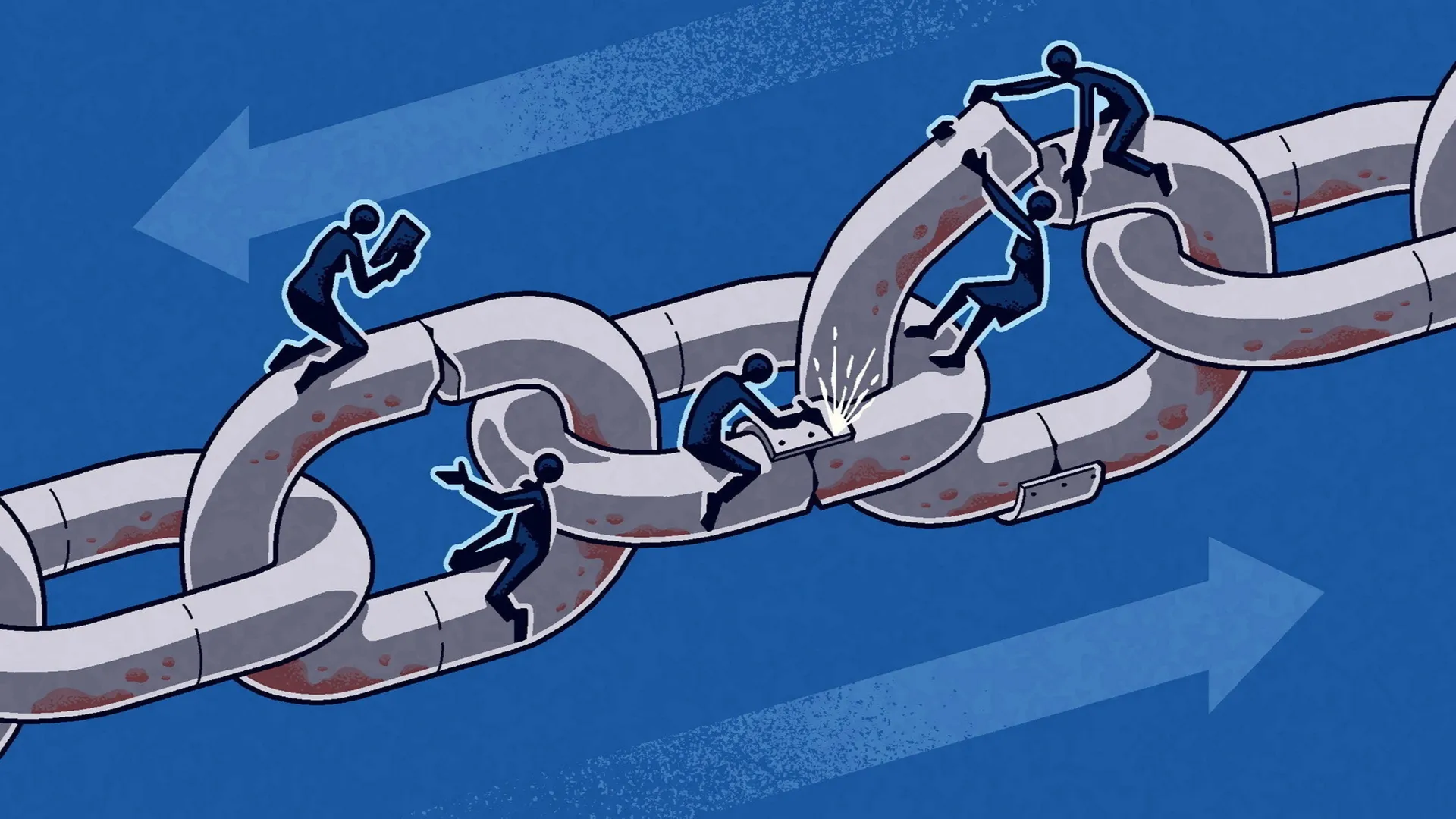尊敬的用戶您好,這是來自FT中文網的溫馨提示:如您對更多FT中文網的內容感興趣,請在蘋果應用商店或谷歌應用市場搜尋「FT中文網」,下載FT中文網的官方應用。

The American economy remains relatively strong, but concerns about its security linger. From the Biden-Harris administration’s opposition to Nippon Steel acquiring US Steel, to proposed tariffs on Chinese cranes that might be used for digital surveillance, to worries about access to rare earth minerals and component parts for crucial industries controlled by adversaries, it’s clear that creating more resilient supply chains is a key issue. And it will remain so no matter who wins the presidential election in November.
美國經濟仍然相對強勁,但關於其安全的擔憂仍然存在。從拜登-哈里斯(Biden-Harris)政府反對日本製鐵(Nippon Steel)收購美國鋼鐵(US Steel),到提議對可能被用於數字監視的中國起重機施加關稅,再到對由對手控制的稀土礦和關鍵行業零組件獲取管道的擔憂,可以明確地看出,成立更具韌性的供應鏈是一個關鍵問題。而且,無論誰在11月的總統選舉中獲勝,這個問題都將繼續存在。
It’s also a topic that will get lots of air time this week in Washington, with the commerce department hosting a supply chain summit and convening a series of meetings with US industry, foreign allies, academics and civil society to discuss how to identify and manage systemic risks in supply chains.
這也是本週在華盛頓備受關注的話題,因爲美國商務部將舉辦供應鏈峯會,並召集美國工業界、外國盟友、學者和民間社會舉行一系列會議,討論如何識別和管理供應鏈中的系統風險。
This is part of an effort led by US commerce secretary Gina Raimondo, who told me last week that the biggest surprise of her tenure was learning “just how unprepared the federal government was to identify and react to supply chain disruptions, and how unsophisticated the approach to this has been for so long”.
這是由美國商務部長吉娜•雷蒙多(Gina Raimondo)領導的努力的一部分,她上週告訴我,她任職期間最驚訝的發現是「聯邦政府在識別和應對供應鏈中斷方面毫無準備,而且長期以來對此問題的處理方式如此不成熟」。
Part of this is down to the fact that the entities holding the best and most granular information about supply chains are private companies. They tend to be looking for individual risks in specific areas, rather than systemic issues across the economy. Governments, on the other hand, may be able to identify the need for more resilience in areas that are crucial for economic or national security — such as semiconductors or pharmaceuticals — but have little understanding of the particulars of each supply chain, or how they might interact with areas like logistics, transport, energy or power in the midst of a crisis.
部分原因在於掌握最佳和最詳細供應鏈資訊的實體是民營公司。它們往往尋找特定領域的個別風險,而不是整個經濟體系的系統性問題。另一方面,政府可能能夠確定在經濟或國家安全關鍵領域(如半導體或製藥)需要更強韌性,但對每個供應鏈的具體情況、以及它們在危機中如何與物流、運輸、能源或電力等領域相互作用瞭解甚少。
This asymmetry was on full display during the pandemic, of course, which is why Raimondo has repositioned the commerce department to focus on supply chains. A key pillar of that effort has been the development of much more robust data analysis to track exactly where the potential chokepoints in the US economy are.
當然,在疫情期間,這種不對稱性得到了充分展示,這也是雷蒙多將商務部的重點轉向供應鏈的原因。該努力的一個關鍵支柱是開發更強大的數據分析,以準確追蹤美國經濟潛在的瓶頸。
To this end, the department has developed the Scale Tool, a computational system which includes data from the entire American goods economy. This is identified and ranked across various industries, geographies and risk metrics (geopolitical, environmental, national security, public health, and so on). The aim is to create an extremely granular picture of where vulnerability and resiliency in the American economy actually lies.
爲此,該部門開發了Scale Tool,這是一個計算系統,包括整個美國商品經濟的數據。這些數據根據不同的行業、地理位置和風險指標(地緣政治、環境、國家安全、公共衛生等)進行識別和排名。目標是成立一個極其詳細的圖景,揭示美國經濟中的脆弱性和韌性所在。
That has required Raimondo and her officials to become familiar with things as esoteric as, for example, the components that go into an AI data centre cooling system. While it’s been widely understood for some time that AI capacity was a potential point of vulnerability for the US, this was thought of mainly in terms of the large amounts of power required for data centres, and whether the grids supporting them were resilient.
這就要求雷蒙多和她的官員們熟悉業內知識,比如用於人工智慧數據中心冷卻系統的組件。雖然人們很早就普遍認識到人工智慧能力是美國的一個潛在薄弱點,但主要是考慮到數據中心所需的大量電力,以及支援它們的電網是否具有韌性。
But in her discussions with chief executives, Raimondo began to understand that the physical structures of the centres were themselves a potential chokepoint. “I realised that the buildings themselves were really sophisticated and that we were going to have to get into the weeds of things like cooling systems, racks and components.”
但在與首席執行長的討論中,雷蒙多開始意識到中心的物理結構本身可能成爲一個瓶頸。「我意識到這些建築本身非常複雜,我們將不得不深入研究諸如冷卻系統、機架和組件之類的細節。」
When the team ran the case through the Scale Tool, what they discovered both validated and added to the anecdotal information coming from industry. Not only does America face potential shortages in cooling components, but the country needs more back up diesel engines in case of grid failure.
當團隊將案例透過Scale Tool分析案例時,他們發現這不僅驗證了來自行業的傳聞資訊,還增加了這類資訊。美國不僅面臨著冷卻部件可能短缺的問題,而且需要更多備用柴油發動機以備電網故障。
The example, one of many, illustrates the need to use both qualitative and quantitative data from industry and the public sector to truly understand supply chain risk. While many economic security conversations are highly political — the Nippon Steel case being a good example — real vulnerabilities tend to come from unexpected places, interacting in ways that no single policymaker or business person could predict.
這只是衆多例子之一,它說明了需要同時使用來自行業和公共部門的定性和定量數據,才能真正理解供應鏈風險。儘管許多經濟安全的討論都是高度政治化的,比如日本製鐵的案例,但真正的脆弱性往往來自意想不到的地方,以一種沒有任何單一決策者或商業人士能夠預測的方式相互作用。
What we know is that there are plenty of economy-wide risks that have yet to be understood or addressed. Data from the commerce department indicates that 57 per cent of industries in America would require six months to return to normal capacity if there was even a single week of transport disruption. So much for the much-heralded shift from “just in time” to “just in case.”
我們所知道的是,還有很多全面經濟風險尚未被理解或解決。美國商務部的數據顯示,如果發生一週的交通中斷,美國57%的行業需要6個月才能恢復正常產能。聲勢浩大的從「及時製造」向「備用製造」的轉變,所得的結果也不過如此。
Likewise, there are unexpected areas of workforce and trade vulnerability that couldn’t have been predicted without burrowing deep into granular data down many levels of global supply chains.
同樣,在勞動力和貿易脆弱性方面還有一些意料之外的領域,如果不深入挖掘全球供應鏈的多個層次的細緻數據,是無法做出預測的。
Ideally, more data would allow policymakers to send the kind of highly targeted demand signals to industry (via more specific and surgical fiscal subsidies or tax incentives) that would increase resilience while not distorting the overall economy or trade system. They might also be used to improve the efficacy of trade negotiations with allies, and dismantle silos in intra-agency policymaking. And I’d love to see the White House Competition Council, which includes commerce, trade, Treasury, transport and other departments, using tools like this to create better policy.
理想情況下,更多的數據可以使決策者向工業界發送高度針對性的需求信號(透過更具體和精確的財政補貼或稅收激勵),從而增加韌性,同時不扭曲整體經濟或貿易體系。它們還可以用於改善與盟友貿易談判的效力,並消除機構內部政策制定中的壁壘。我希望看到包括商務、貿易、財政、交通等部門在內的白宮競爭委員會(White House Competition Council)利用這樣的工具來制定更好的政策。
In economic security, as in anything else, data is power.
在經濟安全領域,就像在其他任何領域一樣,數據就是力量。